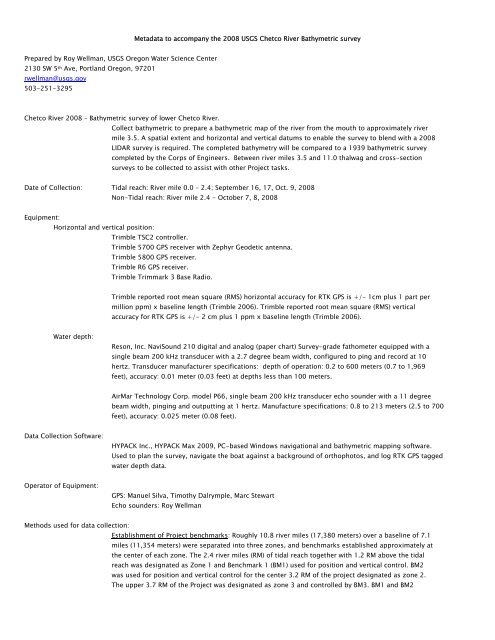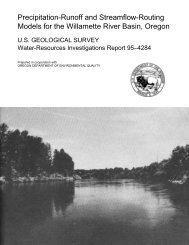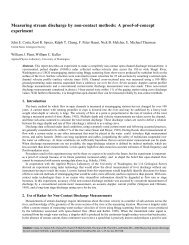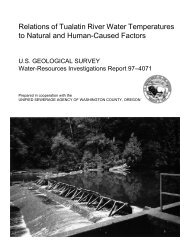Download 2008 bathymetric survey metadata - USGS Oregon Water ...
Download 2008 bathymetric survey metadata - USGS Oregon Water ...
Download 2008 bathymetric survey metadata - USGS Oregon Water ...
Create successful ePaper yourself
Turn your PDF publications into a flip-book with our unique Google optimized e-Paper software.
Metadata to accompany the <strong>2008</strong> <strong>USGS</strong> Chetco River Bathymetric <strong>survey</strong><br />
Prepared by Roy Wellman, <strong>USGS</strong> <strong>Oregon</strong> <strong>Water</strong> Science Center<br />
2130 SW 5 th Ave, Portland <strong>Oregon</strong>, 97201<br />
rwellman@usgs.gov<br />
503-251-3295<br />
Chetco River <strong>2008</strong> – Bathymetric <strong>survey</strong> of lower Chetco River.<br />
Collect <strong>bathymetric</strong> to prepare a <strong>bathymetric</strong> map of the river from the mouth to approximately river<br />
mile 3.5. A spatial extent and horizontal and vertical datums to enable the <strong>survey</strong> to blend with a <strong>2008</strong><br />
LIDAR <strong>survey</strong> is required. The completed bathymetry will be compared to a 1939 <strong>bathymetric</strong> <strong>survey</strong><br />
completed by the Corps of Engineers. Between river miles 3.5 and 11.0 thalwag and cross-section<br />
<strong>survey</strong>s to be collected to assist with other Project tasks.<br />
Date of Collection: Tidal reach: River mile 0.0 – 2.4; September 16, 17, Oct. 9, <strong>2008</strong><br />
Non-Tidal reach: River mile 2.4 - October 7, 8, <strong>2008</strong><br />
Equipment:<br />
Horizontal and vertical position:<br />
Trimble TSC2 controller.<br />
Trimble 5700 GPS receiver with Zephyr Geodetic antenna.<br />
Trimble 5800 GPS receiver.<br />
Trimble R6 GPS receiver.<br />
Trimble Trimmark 3 Base Radio.<br />
Trimble reported root mean square (RMS) horizontal accuracy for RTK GPS is +/- 1cm plus 1 part per<br />
million ppm) x baseline length (Trimble 2006). Trimble reported root mean square (RMS) vertical<br />
accuracy for RTK GPS is +/- 2 cm plus 1 ppm x baseline length (Trimble 2006).<br />
<strong>Water</strong> depth:<br />
Reson, Inc. NaviSound 210 digital and analog (paper chart) Survey-grade fathometer equipped with a<br />
single beam 200 kHz transducer with a 2.7 degree beam width, configured to ping and record at 10<br />
hertz. Transducer manufacturer specifications: depth of operation: 0.2 to 600 meters (0.7 to 1,969<br />
feet), accuracy: 0.01 meter (0.03 feet) at depths less than 100 meters.<br />
AirMar Technology Corp. model P66, single beam 200 kHz transducer echo sounder with a 11 degree<br />
beam width, pinging and outputting at 1 hertz. Manufacture specifications: 0.8 to 213 meters (2.5 to 700<br />
feet), accuracy: 0.025 meter (0.08 feet).<br />
Data Collection Software:<br />
HYPACK Inc., HYPACK Max 2009, PC-based Windows navigational and <strong>bathymetric</strong> mapping software.<br />
Used to plan the <strong>survey</strong>, navigate the boat against a background of orthophotos, and log RTK GPS tagged<br />
water depth data.<br />
Operator of Equipment:<br />
GPS: Manuel Silva, Timothy Dalrymple, Marc Stewart<br />
Echo sounders: Roy Wellman<br />
Methods used for data collection:<br />
Establishment of Project benchmarks: Roughly 10.8 river miles (17,380 meters) over a baseline of 7.1<br />
miles (11,354 meters) were separated into three zones, and benchmarks established approximately at<br />
the center of each zone. The 2.4 river miles (RM) of tidal reach together with 1.2 RM above the tidal<br />
reach was designated as Zone 1 and Benchmark 1 (BM1) used for position and vertical control. BM2<br />
was used for position and vertical control for the center 3.2 RM of the project designated as zone 2.<br />
The upper 3.7 RM of the Project was designated as zone 3 and controlled by BM3. BM1 and BM2
elevations were calculated by positioning a Trimble 5700 over a point, occupying the location for a<br />
minimum of 2.0 hours while recording 30 second static GPS. The recorded static GPS data were<br />
converted to the RINEX2 standard format and submitted to the National Geodetic Survey (NGS) Online<br />
Positional User Service (OPUS) program for NAD83 (horizontal) and NAVD88 (vertical) coordinate<br />
calculation. BM3 was calculated by averaging 5 readings of the point using BM2 as the base station.<br />
Walking <strong>survey</strong>s: Trimble R6 GPS receiver was removed from its mount on the <strong>survey</strong> vessel and<br />
mounted on a fixed length 2-meter pole operating in real-time kinematic (RTK) mode, radio linked to a<br />
Trimble Trimmark 3 connected to Trimble 5700 at either BM2 or BM3 base station to facilitate real-time<br />
differential correction to the position and reference ellipsoid height data. GPS pole heights were verified<br />
using a metal tape measure. Position and ellipsoid heights were logged on the Trimble TSC2 controller.<br />
Boating <strong>survey</strong>s: HYPACK MAX receiving water depth data from either the Reson echo sounder (in the<br />
tidal reach) or the Airmar echo sounder (non-tidal reach) and RTK GPS data from a roving Trimble R6<br />
GPS receiver or a Trimble 5800 GPS receiver, radio linked to a Trimble Trimmark 3 connected to Trimble<br />
5700 base station to facilitate real-time differential correction to the position and reference ellipsoid<br />
height data. RTK GPS receivers were mounted directly above the echo sounder on a tilt adjustable pole<br />
fastened to the side of a 17 ft. flat bottom Lowe boat in the tidal reach, or to the side of a 12 ft canoe in<br />
the non-tidal reach. The elevation offset from the RTK GPS to the centerline of the echo sounder<br />
transducer face was measured by a steel measuring tape at the start of each day, when the instrument<br />
was remounted to the <strong>survey</strong> vessel mount after a walking <strong>survey</strong>, and at the end of each day. Depth<br />
data from the echo sounder was verified by sounding the depth from the surface with a steel tape,<br />
subtracting the depth from the surface to the centerline of the transducers, and comparing the value<br />
with readings received by the HYPACK software. The procedure was performed at the start and end of<br />
each day. Position data were recorded at about 1-second rate and depth data at about 10 points per<br />
second for the Reson echo sounder and 1 point per second for the Airmar echo sounder. Vessel speed<br />
was limited to less than 10 miles per hour to maximize the number of depth measurements gathered for<br />
each <strong>survey</strong>ed line. HYPACK MAX interpolates position coordinates between GPS updates. In the tidal<br />
zone 11.2 miles of transects were collected with cross section spacing averaging 100 feet. In the 8.4 RM<br />
upriver zones, 7.9 miles of transects were collected. About 0.5 RM in the upriver zones were not<br />
collected because of low water depth. Maximum depth recorded by the <strong>survey</strong> was 7.27 meters (23.8<br />
feet). Cross section locations were based on a previous 1979 <strong>survey</strong>.<br />
Methods used for data preparation and processing:<br />
Walking Surveys: Position data is received by the rover RTK GPS receiver in WGS 1984 datum and<br />
transformed into NAD 1983 (Conus) UTM zone 10 coordinates by the receiver. WGS84 reference<br />
ellipsoid height data received by the rover and position data were uploaded into a spreadsheet and the<br />
reference ellipsoid data combined with interpolated Geoid03 heights, supplied by NGS program INTG, to<br />
obtain the orthometric height (NAVD88).<br />
Boat Surveys: The rover RTK GPS receiver position data in WGS 1984 datum and WGS84 reference<br />
ellipsoid height data were combined with echo sounder data using HYPACK MAX running on a laptop<br />
computer. HYPACK MAX combines the WGS84 reference ellipsoid height, the echo sounder transducer<br />
elevation offset, and the recorded echo sounder depth of water obtain the above WGS84 reference<br />
ellipsoid height of the river bottom and transforms the WGS 1984 position data into NAD 1984 UTM<br />
zone 10 grid coordinates. The position data (UTM-longitude-latitude) and reference ellipsoid height<br />
data were exported from HYPACK MAX and processed by the NGS program INTG to obtain interpolated<br />
Geoid03 heights for each data point, which were combined with the channel bottom reference ellipsoid<br />
height to calculate the orthometric NAVD88 height and output a final XYZ (easting-northing-height)<br />
data file.<br />
Horizontal Datum Name:<br />
NAD 1983 UTM zone 10N.<br />
Horizontal Position Accuracy:
GPS Benchmarks: NGS-OPUS computed coordinate accuracies are listed as peak-to-peak values.<br />
Additional information: www.ngs.noaa.gov/OPUS.html#accuracy. Horizontal accuracy of Survey static<br />
datasets processed by NGS-OPUS was +/- 0.097 meters (0.318 feet) latitude and +/- 0.069 meters<br />
(0.226 feet) longitude. GPS rover <strong>survey</strong> checks against Project established control points compare<br />
within 0.040 meters (0.131 feet) to 0.107 meters (0.351 feet) latitude and 0.007 meters (0.023 feet) to<br />
0.080 meters (0.262 feet) longitude.<br />
Walking and boat Surveys: Trimble reported root mean square (RMS) horizontal accuracy for RTK GPS is<br />
+/- 1cm plus 1 part per million (ppm) x baseline length (Trimble 2006). The Project maximum baseline<br />
(4,710 feet) error is +/- 0.0147 meters (0.048 feet).<br />
Vertical Datum Name:<br />
Vertical Position Accuracy:<br />
NAVD 1988<br />
RTK GPS Benchmarks: NGS-OPUS computed coordinate accuracies are listed as peak-to-peak values.<br />
Additional information: www.ngs.noaa.gov/OPUS.html#accuracy. Vertical accuracy of Survey static<br />
datasets processed by NGS-OPUS was +/- 0.329 meters (1.079 feet) for ellipsoid height and +/- 0.331<br />
meters (1.085) for orthometric height.<br />
Walking and boat Surveys: Trimble reported root mean square (RMS) vertical accuracy for RTK GPS is +/-<br />
2 cm plus 1 ppm x baseline length (Trimble 2006). The Project maximum baseline (4,710 feet) error is<br />
+/- 0.0247 meters (0.081 feet). Reson model 210 manufactures specifications depth of operation from<br />
0.2 to 600 meters (0.7 to 1,969 feet). Accuracy is 1 centimeter (0.033 feet) at depth less than 100<br />
meters. Airmar model P66 specifications are unreported.<br />
Inside the Project boundary, the RTK GPS rover checks against the Project established control points<br />
compare orthometric height within 0.019 to 0.086 meters (0.062 to 0.282 feet). Combined with the<br />
accuracy of the benchmarks, total Project accuracy is 0.359 to 0.357 meters (1.147 to 1.171 feet).<br />
Distance Units:<br />
Positions and elevations in meters.<br />
03-31-09 Roy E. Wellman<br />
04-06-09 Checked G.W. Hess<br />
05-17-10 edits: Roy E. Wellman


